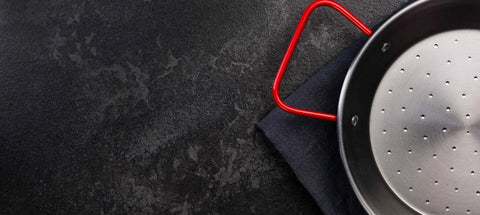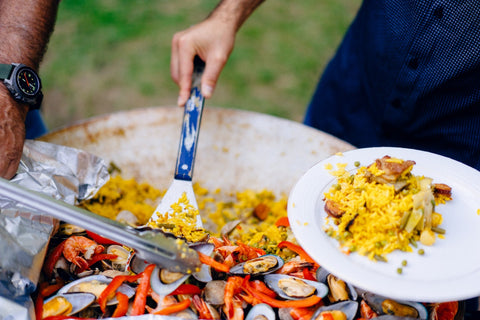If you're a fan of Spanish cuisine, chances are you've heard of paella - a delicious rice dish that's bursting with flavor and tradition. Paella is not only a beloved Spanish dish, but it's also a social event that brings family and friends together. However, to make a delicious paella, you need the right tools, and the most important of these is the paella pan. In this guide, we'll cover everything you need to know about paella pans, including the differences between materials, ideal sizes, and compatibility with different cooking surfaces. We'll also provide tips for cleaning and maintaining your paella pan, so you can enjoy delicious paella for years to come.
Understanding the Differences Between Polished Steel, Enameled, Induction, and Stainless Steel - Which One is Right for You?
Polished Steel Paella Pans
Polished steel paella pans are the traditional paella pans and are made of steel without any additional coating. This type of pan requires some care and maintenance, as it can rust if not dried and stored properly after each use. However, polished steel has the advantage of heating up quickly and distributing heat evenly, which helps to cook the paella evenly. Polished steel paella pans are a good option if you prefer a traditional option and don't mind doing a bit more maintenance.
Enameled Paella Pans
Enameled paella pans have an enamel coating on the surface of the pan. This coating is resistant to rust and corrosion and is easy to clean. Enameled paella pans are also a good option if you don't want to worry about rust and maintenance. However, the enamel can crack or scratch with frequent use and exposure to high temperatures. Enameled paella pans are a great choice if you want a low-maintenance option that is easy to clean.
Induction Paella Pans
Induction paella pans are made specifically for use with induction cooktops. They have a magnetic bottom that allows them to heat up quickly and evenly. Induction paella pans are a good option if you have an induction cooktop and want a pan that heats up quickly and evenly. However, they are not suitable for use with gas or electric cooktops.
Stainless Steel Paella Pans
Stainless steel paella pans are a modern and versatile option. They are made of stainless steel, which is durable, rust-resistant, and easy to clean. Stainless steel paella pans are suitable for use with all types of cooktops, including gas, electric, and induction. They are also dishwasher safe, making them a convenient option for everyday use. Stainless steel paella pans are a great choice if you want a low-maintenance and versatile option that is suitable for all types of cooktops.
In conclusion, the choice of paella pan ultimately depends on personal preferences and needs. Polished steel paella pans are the traditional and classic choice, while enameled paella pans are low-maintenance and easy to clean. Induction paella pans are suitable for use with induction cooktops, while stainless steel paella pans are a modern and versatile option suitable for all types of cooktops. Whatever type of paella pan you choose, it is important to choose a high-quality pan that is sturdy and has a good thickness, as this will affect the heat distribution and cooking of the paella rice.
Size Matters: How to Choose the Right Paella Pan for Your Cooking Needs

The ideal size for a paella pan depends on the number of people you are serving and the type of paella you are making. As a general rule, a paella pan should be wide and shallow, allowing for the rice to cook evenly and form a thin layer. This ensures that each grain of rice cooks evenly and absorbs the flavors of the other ingredients.
For a traditional Valencian paella, which typically serves 4-6 people, a 14-16 inch (35-40 cm) paella pan is recommended. This size allows for the rice to cook evenly and for the socarrat, the caramelized crust that forms on the bottom of the paella, to develop properly.
For larger paellas or for serving more people, larger pans can be used. However, it is important to keep in mind that the paella should not be too deep, as this can cause the rice to cook unevenly and lead to a less than ideal result.
On the other hand, if you are cooking for just a few people or making a smaller batch of paella, a smaller pan can be used. It is important to adjust the cooking time and technique accordingly to ensure that the rice cooks evenly and the paella is not overcooked.
Ultimately, the ideal size of a paella pan depends on the specific recipe and number of people you are serving, so it's important to choose a size that fits your needs.
Can you use a paella pan on a regular stovetop or do you need a specialized burner?
Yes, you can use an induction paella pan on a regular stovetop as long as it is compatible with the type of stove you have. An induction paella pan is specifically designed to work with induction stovetops, which use a magnetic field to create heat.
Induction paella pans are typically made of stainless steel or other magnetic materials that can conduct heat efficiently. They have a flat bottom with no ridges, which allows for even heat distribution and helps to create the characteristic socarrat.
If you have an induction stovetop and plan to cook paella, using an induction paella pan is an excellent option. However, if you have a traditional gas or electric stove, you may want to consider using a specialized paella burner instead. A specialized burner can provide better heat distribution and control, which can help to prevent uneven cooking and ensure that the paella develops the characteristic socarrat.
In summary, an induction paella pan can be used on a regular stovetop as long as it is compatible with the type of stove you have. However, using a specialized paella burner can provide better heat control and produce even better results, especially if you plan to cook paella regularly.

Can you use a paella pan on a grill or over an open flame?
Yes, you can use a paella pan on a grill or over an open flame, as paella was originally cooked over an open fire. However, there are some important considerations to keep in mind.
First, the size of the paella pan should match the size of the grill or fire. It is also important to use a sturdy and heat-resistant paella pan that can withstand the high heat of a grill or open flame. Carbon steel and stainless steel paella pans are good options for this type of cooking.
Second, it is important to control the heat to prevent burning or uneven cooking. If using a grill, you can adjust the temperature by moving the paella pan to different areas of the grill, or by adjusting the heat source if using an open flame. You can also use a diffuser or a layer of sand or bricks under the paella pan to help distribute the heat evenly.
Finally, cooking paella on a grill or over an open flame may require more attention and skill than cooking on a stovetop or specialized burner. It is important to constantly monitor the paella and adjust the heat as necessary to prevent burning or overcooking.
In conclusion, using a paella pan on a grill or over an open flame is possible, but it requires careful attention and control of the heat. Choosing the right size and type of paella pan, and monitoring the cooking process closely, can help to produce a delicious and authentic paella.
How do you properly clean and maintain a paella pan?
Proper cleaning and maintenance are important for keeping your paella pan in good condition and ensuring its longevity. Here are some tips for cleaning and maintaining your paella pan:
-
After cooking, allow the paella pan to cool down before cleaning it. Never submerge a hot paella pan in cold water, as this can cause warping or damage.
-
Use hot water and a soft sponge or brush to clean the paella pan. Avoid using abrasive scrubbers or harsh detergents, as these can scratch the surface or damage the natural non-stick coating of the pan.
-
If there are any stubborn food residues or stains, you can soak the pan in hot water with a little bit of mild detergent. Do not use bleach or other strong chemicals.
-
After cleaning, dry the paella pan thoroughly with a towel or air-dry it. Do not store the pan while it is still wet, as this can cause rust or corrosion.
-
To maintain the natural non-stick coating of a carbon steel paella pan, you can season it periodicall. Rub a small amount of vegetable oil onto the surface of the pan, then heat it over medium-high heat until it starts to smoke. Remove the pan from the heat, let it cool down, and wipe off any excess oil with a paper towel.
-
Store the paella pan in a dry and well-ventilated area. If you are storing it for a long time, you can apply a thin layer of vegetable oil to prevent rust and corrosion.
By following these tips, you can keep your paella pan in good condition and ensure that it lasts for many years of delicious paella cooking.
Conclusion
In conclusion, a paella pan is an essential tool for cooking authentic paella. When choosing a paella pan, it is important to consider the material, size, and compatibility with your cooking surface. Carbon steel is the traditional material for paella pans, while stainless steel and enameled pans are also popular options. The ideal size of your paella pan will depend on the number of servings you need.
If using a stovetop, make sure to choose a pan compatible with your heat source, whether it be gas, electric, or induction. A specialized paella burner is recommended for outdoor cooking on a grill or over an open flame.
Proper maintenance and cleaning of your paella pan will help extend its lifespan and ensure consistent cooking results. Carbon steel pans require more attention and seasoning than stainless steel or enameled pans, but with proper care, they can last a lifetime.
Investing in a high-quality paella pan and taking the time to care for it properly will ensure that you can enjoy delicious paella for years to come.




